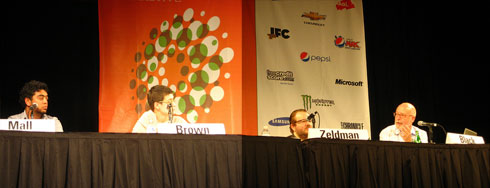THE FIRST THING I got about the web was its ability to empower the maker. The year was 1995, and I was tinkering at my first website. The medium was raw and ugly, like a forceps baby; yet even in its blind, howling state, it made me a writer, a designer, and a publisher — ambitions which had eluded me during more than a decade of underachieving desert wanderings.
I say “it made me” but I made it, too. You get the power by using it. Nobody confers it on you.
I also got that the power was not for me alone: it was conferred in equal measure on everyone with whom I worked, although not everyone would have the time or desire to use the power fully.
The luckiest makers
Empowerment and desire. It takes extraordinary commitment, luck, and talent to become a maker in, say, music or film, because the production and distribution costs and risks in these fields almost always demand rich outside investors and tightly controlling corporate structures. (Film has held up better than music under these conditions.)
Music and film fill my life, and, from afar, I love many artists involved in these enterprises. But they are mostly closed to you and me, where the web is wide open, and always has been. We all know gifted, hard working musicians who deserve wide acclaim but do not receive it, even after decades of toil. The web is far kinder to makers.
To care is to share
Not only does the web make publishers of those willing to put in the work, it also makes most of us free sharers of our hard-won trade, craft, and business secrets. The minute we grab hold of a new angle on design, interaction, code, or content, we share it with a friend — or with friends we haven’t met yet. This sharing started in news groups and message boards, and flowered on what came to be called blogs, but it can also slip the bounds of its containing medium, empowering makers to create books, meet-ups, magazines, conferences, products, you name it. It is tough to break into traditional book publishing the normal way but comparatively easy to do it from the web, provided you have put in the early work of community building.
The beauty is that the community building doesn’t feel like work; it feels like goofing off with your friends (because, mostly, it is). You don’t have to turn your readers into customers. Indeed, if you feel like you’re turning your readers into customers, you’re doing it wrong.
If you see a chance, take it
The corollary to all this empowerment is that it’s up to each of us to do something positive with it. I sometimes become impatient when members of our community spend their energy publicly lamenting that a website about cats isn’t about dogs. Their energy would be so much better spent starting bow-wow.com. The feeling that something is missing from a beloved online resource (or conference, or product) can be a wonderful motivator to start your own. I created A List Apart because I felt that webmonkey.com wasn’t enough about design and highfive.com was too much about it. If this porridge is too hot and that porridge is too cold, I better make some fresh, eh?
I apologize if I sometimes seem snippy with whiners. My goal is never to make anyone feel bad, especially not anyone in this community. My message to my peers since the days of “Ask Dr Web” has always been: “you can do this! Go do it.” That is still what I say to you all.








